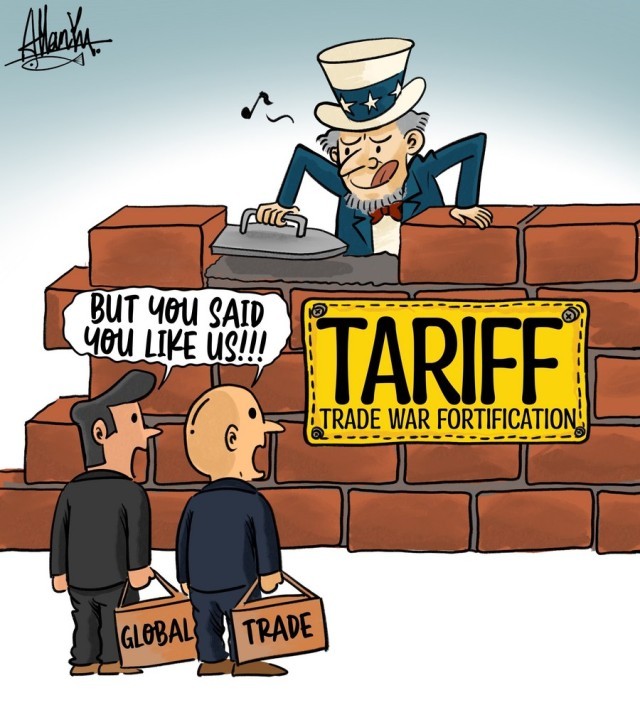Trump's Trade Policy: 10% Tariff Baseline And The Search For Exceptional Offers

Table of Contents
The 10% Tariff as a Baseline: Its Rationale and Impact
The 10% tariff, while not universally applied, served as a foundational element of Trump's trade policy. Its implementation aimed to achieve several key objectives:
The stated goals of the 10% tariff:
- Protecting American industries: The administration argued that tariffs were necessary to shield domestic industries from unfair competition, particularly from countries perceived as engaging in dumping or manipulating their currencies.
- Leveling the playing field: The belief was that tariffs could create a more equitable trade environment by counteracting perceived trade imbalances and unfair practices by other nations.
- Increasing domestic manufacturing jobs: A central promise of the policy was the creation of American jobs through the revitalization of domestic industries.
Specific sectors targeted included:
- Steel: Tariffs were imposed to protect the American steel industry, which had faced significant challenges from foreign competition.
- Aluminum: Similar tariffs were implemented to support the domestic aluminum industry.
However, the actual impact diverged from the stated goals. While some sectors experienced short-term gains, others suffered from increased input costs. Data on job creation in these sectors remain contested, with studies showing varying results and a lack of clear evidence of significant net job growth directly attributable to the tariffs.
Economic consequences of the 10% tariff:
The 10% tariff, and the retaliatory tariffs it provoked, had significant economic consequences:
- Inflation: Increased import costs led to higher prices for consumers on a range of goods, contributing to inflationary pressures.
- Price increases for consumers: Consumers faced higher prices for goods ranging from automobiles to appliances, impacting household budgets.
Economic data from the period reflect increases in inflation and a complex picture regarding trade deficits, with some improving and others worsening depending on the specific trading partner.
- Retaliatory tariffs from other countries: The imposition of tariffs by the US triggered retaliatory measures from countries like China and the European Union, escalating trade tensions and disrupting global supply chains.
International reactions to the 10% tariff:
The 10% tariff initiated a series of significant trade disputes:
- Trade wars with China: The US engaged in a protracted trade war with China, characterized by escalating tariff increases and counter-tariffs.
- Trade disputes with the EU: The EU responded to US tariffs with retaliatory measures, affecting various sectors and exacerbating transatlantic trade tensions.
- Trade disputes with other trading partners: Disputes arose with several other countries, highlighting the widespread impact of Trump's trade policy.
The Pursuit of Exceptional Trade Deals: Case Studies
Trump's administration pursued bilateral trade agreements, aiming for "exceptional deals" that prioritized American interests.
Negotiations with China:
The trade war with China culminated in the "Phase One" trade deal, which involved certain concessions from both sides. However, the long-term effectiveness of this deal remains a subject of debate, with ongoing concerns about intellectual property protection and market access.
Key concessions included: China's commitment to purchase a significant amount of American agricultural products and increased protection of intellectual property rights.
Trade agreements with Mexico and Canada (USMCA):
The USMCA replaced NAFTA, introducing several key changes: stronger labor and environmental provisions, updated rules of origin for automobiles, and a dispute resolution mechanism. The impact on trade flows between the three countries has been mixed, with some sectors experiencing growth while others have faced challenges adapting to the new regulations.
Deals with other countries:
The administration also engaged in trade negotiations and disputes with various other countries. These interactions varied in their outcomes, with some resulting in revised trade agreements while others remained contentious.
Evaluating the Success of Trump's Trade Policy:
Assessing the success of Trump's trade policy requires examining multiple metrics:
Metrics for assessing success:
- Job growth: The impact on job creation and loss in specific sectors is a key indicator.
- Trade deficits: Changes in trade balances provide insights into the effectiveness of the policy in reducing trade imbalances.
- Economic growth: The overall effect on economic growth needs to be considered, encompassing both positive and negative consequences.
- Consumer prices: The impact on inflation and consumer prices is crucial for evaluating the policy's effect on household budgets.
Data from the period show a mixed picture across these metrics, with no single, conclusive assessment of success or failure.
Long-term impacts of the policy:
The long-term consequences of Trump's trade policy on global trade relations and the US economy remain uncertain. The sustainability of its protectionist approach is questioned by many economists who advocate for greater global cooperation.
Alternative approaches to trade policy:
Multilateral agreements, focusing on cooperation and mutually beneficial outcomes, offer an alternative approach to achieving similar goals. These approaches often prioritize collaborative solutions and address broader trade concerns.
Conclusion: Understanding the Legacy of Trump's Trade Policy and the 10% Tariff
Trump's trade policy, centered around a 10% tariff baseline and a pursuit of exceptional trade deals, significantly impacted global trade relations. While some sectors experienced short-term gains, the overall economic consequences were complex and multifaceted, affecting inflation, consumer prices, and international relations. The long-term effects, including the sustainability of the protectionist approach and its impact on global trade architecture, remain subjects of ongoing debate and research. Further research into the intricacies of Trump's trade policy, specifically the impact of the 10% tariff baseline and the pursuit of exceptional deals, is crucial for understanding the current state of global trade and developing more effective strategies for future trade negotiations.

Featured Posts
-
 Breaking The Doom Loop How Cities Are Using Sports Stadiums
May 11, 2025
Breaking The Doom Loop How Cities Are Using Sports Stadiums
May 11, 2025 -
 Yankees Vs Giants Tracking Injuries During April 11 13 Series
May 11, 2025
Yankees Vs Giants Tracking Injuries During April 11 13 Series
May 11, 2025 -
 Yankees Brewers Series Whos On The Injured List March 27 30
May 11, 2025
Yankees Brewers Series Whos On The Injured List March 27 30
May 11, 2025 -
 Crazy Rich Asians A Tv Series Is Coming To Hbo Max
May 11, 2025
Crazy Rich Asians A Tv Series Is Coming To Hbo Max
May 11, 2025 -
 Jessica Simpson And Eric Johnson A Public Appearance Amidst Separation
May 11, 2025
Jessica Simpson And Eric Johnson A Public Appearance Amidst Separation
May 11, 2025
